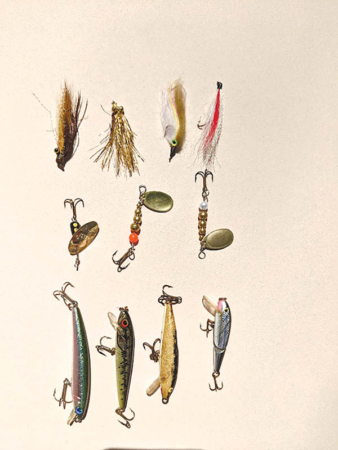As the title of this piece indicates, for those who trout fish, minnows are a top producer when it comes to trout fishing. It’s a well-known fact that all trout feed on smaller fish or minnows, so it makes good sense to utilize such bait when fishing for trout. Because minnows are such good trout bait, it also makes sense that there are a variety of minnow imitations available to trout fishermen.
Certainly, a live minnow presented properly will rank pretty high as a good trout producer. Back in my college days, a good friend of mine who was a diehard minnow fisherman used nothing but live minnows for trout fishing. I tagged along one day, and after seeing him hook up a half-dozen times on some pretty good trout, it didn’t take me long to start copying his technique. The rig was fairly simple; he tied a small loop at the business end of his six-pound test mono and then, with a minnow needle, pulled the loop through the mouth of the minnow and out in front of the anal fin. A double or treble hook was placed on the loop, and the rig was pulled up snug to the minnow’s body. Add whenever split-shot was necessary to get down to the desired depth, and you were ready to go. Most casts were across and slightly downstream and retrieved with a stop and go motion — very effective.
Well, I’ve got news for you; if you are not into the live bait approach, there are minnow imitations out there that may well be just as effective. An added plus is there is no need to buy, collect or maintain live minnows. For years spin fishermen have been using spinners like the CP Swing and Mepps to take trout. Again like my minnow fishing buddy, I know a couple of brothers who fish for trout with nothing but spinners, and they even make their own. I’m always looking for ways to add to my own arsenal, so I joined them one day on a stream near State College. They both preferred to wade into the water and cast upstream, and then retrieve the spinner downstream with the current. They were also very efficient casters placing their spinners close to the edge of the bank without hang-ups. They caught plenty of trout that day, and needless to say, I’ve added that technique to my list of possibilities.
Also, in the artificial department, I must mention minnow plugs like the Rebels and Rapalas. Actually, several other companies produce minnow-type plugs that are equally as good. I still like the black and silver and black and gold colors, but there is a vast array of colors and patterns available. Also, these plugs come in floating and sinking models and with different lips to create different actions. Probably the main thing to keep in mind is size; usually, a two to three-inch size is good for trout fishing.
When it comes to trout fishing, I’ll be honest, about 99 percent of the time, I’m using a flyrod but be assured the fly angler is not left out of the “minnow” approach to taking trout. The minnow imitations in the fly fishermen’s world are known as streamers —artificial flies made with an assortment of hair, feathers, and other materials that can be made to look like fleeing minnows when properly worked. A couple of weeks ago, I was fishing one of the special regulated fly stretches on a nearby stream. I picked up a couple of trout on a nymph rolling naturally along the bottom, but I decided to work with a streamer for a while. I tied on a streamer with gold flashy material and picked up four nice trout in a short time —better action than I was having with the nymph.
Whatever presentation you decide to use — live minnow, metal spinner, plastic minnow lure, or tied feathers and assorted materials there’s a good chance you will have some success with “minnows.”




